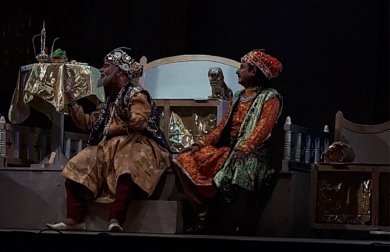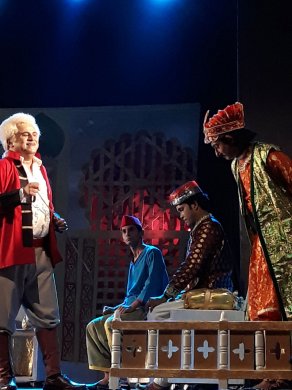
|   |

|   |
 e-mail: ukb7@rediffmail.com A post-Plassey phantasmagoria October 30, 2018 Tagore wrote perceptively: The weighing scales of the shopkeeper reappeared as the royal sceptre once the night was over... The poet's allusion was to the ignominious Battle of Plassey (Palashi, in Bengali), waged near the then capital Murshidabad in 1757 between the Nawab Siraj-ud-Daulah, the last independent Nawab of Bengal, and the British East India Company, and led by Colonel Robert Clive and Admiral Watson. The British, worried about being outnumbered, formed a conspiracy with Siraj-ud-Daulah's demoted army chief Mir Jafar, along with others such as Jagat Seths (Mahtab Chand and Swarup Chand), Umichand, Rai Ballav, Rai Durlabh and others. The conspirators assembled their troops near the battlefield but made no move to actually join the battle. Siraj-ud-Daulah's army with 50,000 soldiers, 40 cannons and 10 war elephants was defeated by 3,000 soldiers of Robert Clive, owing to the flight of the Nawab from the battlefield and the inactivity of the conspirators.  Judged to be one of the pivotal battles for the control of Indian subcontinent by the colonial powers, the battle - lasting only 11 hours on a hot June day -- paved the way for the British to wield enormous influence over the Nawab and consequently acquired significant compensations for previous losses and fresh revenue from trade. The British further used the money to increase their military might and push the other European colonial powers such as the Dutch and the French out of South Asia, thus leading to the eventual rise of the British Empire. Mir Jafar, presented on September 25 in Kolkata by Kalindi Bratyajon, recapitulated on a grand scale the turbulent time period ranging from four months after that historic battle in 1757 till the year 1764, just before the battle of Buxar, waged by Mir Kasim as one final effort to dislodge the usurping British traders, but to be decisively quashed by the latter. In the play, the murky annals of Bengal were played out almost like a fantasia: as a sequence of real or imaginary images quite often like that seen in a dream. The play was written - with a painstaking historical research - as well as directed by the thespian Braya Basu, who opines, "My play embodies the various layered progression of how in these seven years the East India Company and colonial powers gradually manoeuvred their aggression to capture and control the contemporary Nawabi Empire of Bengal. I don't merely capture the 260-year-old history, but also deconstruct and re-construct it." In a rapidly changing scenario, Mir Jafar (played quite credibly by Goutam Halder) had his role cast in the gigantic tragi-comic mould of a Shakespearean Macbeth: now mock-heroic, now delusional and desperate. Sans the caring support of a Lady Macbeth, this character - tinged by Goutam's mannerisms and supported by the liberal drinks of Bhang (the boiled narcotic juice from cannabis leaves) - depicted the enormous frustration increasingly evident in his all too short a rule. The dream scenes were well enacted with dollops of fun and merriment -- like both Mir Jafar and his son Miran simultaneously serenading Siraj's comely widow Lutfunnesa, or, the make-belief dream of Mir Jafar coming back to wield power alongside his ever-fawning courtiers. Miran (surprisingly well enacted by the veteran Kanchan Mullick, who normally essays only comic roles) was the alternative power centre and constantly dreaming of continuing his progeny as future Nawabs of Bengal. The trouble was his adopting realistic mode of acting against his father's out-and-out stylisation. Especially in the fantasy sequences, this made a strange cocktail. The same could be said for Bratya's own competent depiction of Robert Clive. Nobody would blame him for sticking to a Bengali dialogue and avoiding accented English, but his suave, realist manners and delivery hardly went hand-in-hand with Mir Jafar's utter stylisation and body language. As a director, he seemed legitimately concerned to make his play relevant to the present age, constructing prolonged dream-scenes of dance and merry-making with RD Burman's Hindi popular ditty, Hum kaale hain to kya dilwaale hain..., where Clive too danced away, yet this could not be rated very high on an aesthetic scale.  Poulami Basu's dignified white-attired Lutfunnesa, as the royal grieving widow, made a distinctive impact in the graveyard scene. But the production's accent on fantasia brought her also down to the song-and-dance frolicking with the Hindi libretto and the latter, once again, made strange bed-fellows with the serene Baroque music of Sebastian Bach played during Clive's suicide scene - when he was being publicly harangued by the British Parliament for his feudal excesses in India -- in the seclusion of his London home. The set-design and stage props by Partha Majumder were spectacular. Costume by Malobika Mitra had paid adequate attention to the historical period. But light design from Dinesh Poddar fell a little short of the usual perfection expected from this master. Bratya's efforts as a playwright-researcher are best summed up in his own words, "My digging into history welled up endless fountains rumbling on pebbles and explored sources of confined water bodies. I am like the old village story-teller who uncovers the earthy layers with a craving to open the islands hidden underneath. A new truth tumbles out from within, which is beyond the contemporary comprehension in its excesses of time and reality. My 250 to 275-year-old ancestors appear to be playing their orchestrated bands and marching past the horizons of our modern times. When their faces turn towards us, we salute them from our secure viewing platforms at times, but reproach them too at other times..." And here is what Batya, as a seasoned director, has to say about his chosen craft in building up the play and letting it work out. "In the process, we wanted to experience the topsy-turvy world of the snake-and-ladder game. As soon as we got a glimpse of the dawn by removing the fog, the horizon is covered up by haze again. So, at some point of time, we also try to search for our self-identity that embarrasses us and troubles us as well. But, in the end, it becomes adorable: because of this unpredictable eccentricity of roaming aimlessly like a vagabond, like a hunter with a bundle of bows tied around his waist. To use another metaphor, the fishy smell continues to spread its not so agreeable fragrance across the core of the Gangetic plain, in the livelihoods of its inhabitants across the whole span of time-city-nation. It is actually this fašade that is ever changing, but life moves on and so do the days of the inexorable calendar..."  Dr. Utpal K Banerjee is a scholar-commentator on performing arts over last four decades. He has authored 23 books on Indian art and culture, and 10 on Tagore studies. He served IGNCA as National Project Director, was a Tagore Research Scholar and is recipient of Padma Shri. Post your comments Please provide your name and email id when you use the Anonymous profile in the blog to post a comment. All appropriate comments posted with name & email id in the blog will also be featured in the site. |